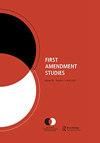Rhetorical interventions in the law: Interpreting “I ♥ Boobies!”
Q2 Social Sciences
引用次数: 1
Abstract
Abstract In 2013, the Third Circuit Court of Appeals ruled that a group of students were within their constitutional rights to wear breast cancer awareness bracelets that read: “I ♥ Boobies!” The majority opinion in B.H. and K.M. v. Easton Area School District called on judges to determine whether a student’s speech was “plainly” or “ambiguously” lewd, and also whether it could “plausibly be interpreted as commenting on political or social issues.” Cases like B.H. provide an excellent opportunity for rhetorical scholars to engage the law—asserting their expertise in the methods of interpretation germane to vernacular persuasive discourses.法律中的修辞干预:解读“我爱咪咪!”
2013年,第三巡回上诉法院裁定,一群学生戴上写着“我爱咪咪!”的乳腺癌意识手镯,这是宪法赋予他们的权利。在B.H.和K.M.诉伊斯顿地区学区案(B.H. and K.M. v. Easton Area School District)一案中,多数意见要求法官判断学生的言论是“明显”还是“含糊”猥亵,以及它是否可以“合理地被解释为对政治或社会问题的评论”。像B.H.这样的案例为修辞学学者提供了一个极好的机会,让他们参与到法律中来——主张他们在与白话说服性话语相关的解释方法方面的专业知识。
本文章由计算机程序翻译,如有差异,请以英文原文为准。
求助全文
约1分钟内获得全文
求助全文
来源期刊

First Amendment Studies
Social Sciences-Law
自引率
0.00%
发文量
0
期刊介绍:
First Amendment Studies publishes original scholarship on all aspects of free speech and embraces the full range of critical, historical, empirical, and descriptive methodologies. First Amendment Studies welcomes scholarship addressing areas including but not limited to: • doctrinal analysis of international and national free speech law and legislation • rhetorical analysis of cases and judicial rhetoric • theoretical and cultural issues related to free speech • the role of free speech in a wide variety of contexts (e.g., organizations, popular culture, traditional and new media).
 求助内容:
求助内容: 应助结果提醒方式:
应助结果提醒方式:


